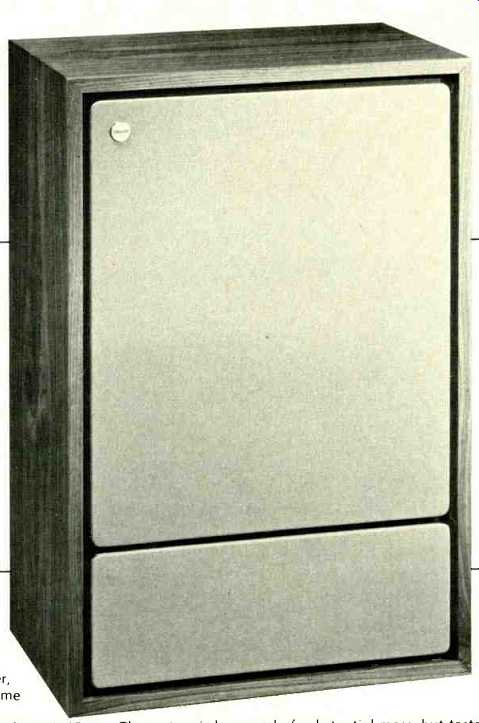
MANUFACTURER'S SPECIFICATIONS
Speakers: One 15 in. woofer mounted in a ducted port enclosure, and a two-in. concentrically mounted compression driver.
Frequency Response: 35-20,000 Hz.
Crossover: 1000 Hz.
Impedance: 8 ohms nominal.
Power Handling: 85 watts continuous program material.
Dimensions: 33 in. (83.8 cm) x 21 in. (53.3 cm) x 12 in. (30.5 cm.).
Weight: 90 lbs. (40.8 kg).
Price: $480.00.
Tannoy is an old and respected name in the field of high quality sound reproduction Made in England, the Berkeley is a substantial sized two-way loudspeaker system in the Tannoy line which uses their unique direct radiator bass unit and high-frequency compression driver, both located concentrically within the same frame and magnet assembly.
In this ducted port system, the low frequency radiator is 15 inches (381 mm) in diameter and carries the frequency range from 35 Hz to the crossover at 1 kHz. The coaxially mounted 2 inch (51 mm) compression driver then takes over from 1 kHz upward.
The system is large and of substantial mass, but tastefully accented so that it does not overwhelm normal living room decor. The enclosure is finished in oiled walnut with two removable brown cloth covered grilles. The upper, and larger, grille covers the loudspeaker cone and, while removable, need not be removed by the user. The lower grille covers two switched equalizer controls. These controls are intended to allow for minor higher frequency adjustments which a user might set to suit his particular tastes in music reproduction.
Connection is made to spring loaded terminals mounted in a recessed cavity on the rear of the enclosure, and connectors and controls are legibly marked and should offer no problems for even the most inexperienced user of audio equipment. In addition, Tannoy provides an excellent technical manual with each loudspeaker system which thoughtfully discusses system hookup and maintenance.
Technical Measurements
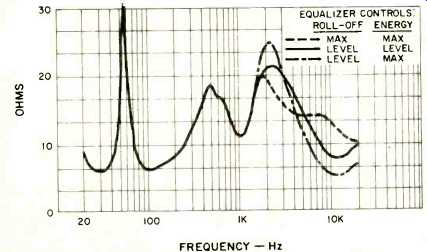
Fig.1.--Magnitude of impedance for three equalizer settings.
The Tannoy " Berkeley" Integrated Loudspeaker system is provided with two equalization controls located on the front baffle. These are labeled Roll-off and Energy and can be used to compensate the response at the higher frequency portion of the spectrum. There are four positions of Roll-off and five positions of Energy, giving 20 possible combinations. As is common with equalizer controls, the loudspeaker terminal impedance is influenced by this adjustment. All 20 ...
[...missing content...]
... minimum phase in its response. Another unusual property is that the first sound which reaches the listener's ear is that of the woofer, which occurs 0.39 milliseconds prior to the first tweeter sound.

The results of the three-meter room test, shown in Fig. 5, tends to verify the earlier listening impression of a strong middle and upper register with the extreme top end somewhat down in level. Both equalizers were adjusted to the "level" condition for this room test and the Tannoy was placed flat against a wall.
The polar energy response for four combinations of equalizer position is shown for azimuth in Fig. 6 and elevation in Fig. 7. This speaker system has a very smooth angular dispersion of sound. The smooth vertical response does, in fact, seem to account for the diffraction dips in the room response of Fig. 5 compared to the rather smooth anechoic response of Fig. 3. Although the Tannoy was placed on a rug surface, it is evident that enough sound can reflect off the floor to cause interaction with the direct air path sound to a listener's ear. While it may not be practical to raise this speaker system off the floor due to its substantial size and weight, these tests do show that large objects which can reflect sound should be kept away from the vicinity of the front of the enclosure, and these speakers should definitely be kept away from overhead projecting surfaces. A small benefit in spectral balance can be obtained by rotating the speakers toward the listening area.
Harmonic distortion for the tones E1 (41.2 Hz), A2 (110 Hz), and A4 (440 Hz) is shown in Fig. 8, and it is a bit higher than I would like to see in a system which is intended for the very highest sound reproduction, particularly at the lower frequencies. However, the uniform increase of distortion with in creasing sound pressure will make this less noticeable than would a sharp increase at some power level. The subjective "mud" in program material be than by these measurements.
Intermodulation distortion of 440 Hz by 41.2 Hz is shown in Fig. 9. The two tones are mixed in equal amplitude and the cross-modulation bf the higher tone is plotted as a percentage of the higher tone. Unlike the harmonic distortion, intermodulation distortion in the Tannoy is quite low right up to the very highest sound levels. Most of this intermodulation consists of amplitude modulation of 440 Hz by the 41.2 Hz bass tone. At both one watt and 100 watt average levels, the phase modulation is three degrees peak to peak and climbs to 10 degrees peak to peak at 60 watts average. There is an average offset of cone position due to the low frequency tone which causes a time delay of the higher tone by an amount corresponding to about 10 microseconds. All loudspeakers have this to some extent and the subjective correlative is a spatial smearing of the reproduced sound image. In the Tannoy the extent of this delay is low enough to be negligible.
The ability to handle complicated program dynamics is measured by mixing Gaussian band-limited noise with a single frequency tone and measuring the spectral smear which is produced on this tone by the noise. In this crescendo test, the Tannoy scores moderately well, causing a drop of tonal energy by 0.5 dB at a combined 12.5 watt peak signal plus noise, and 0.7 dB at 253 watt peak levels for a tone of 440 Hz. Large orchestral peaks should therefore be handled well with little image smear due to random bursts of sound level.
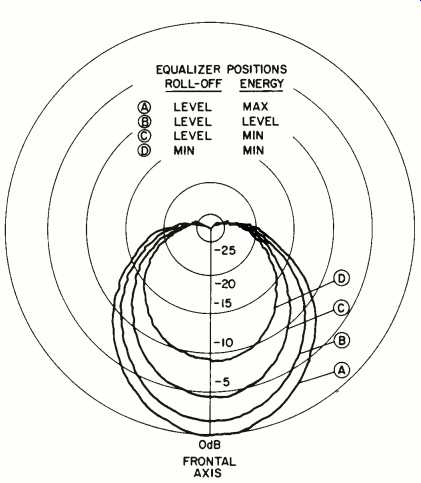
Fig. 6-Horizontal energy response.

Fig. 7-Vertical polar energy response.
The Tannoy shows a very slight, drop of acoustic transfer gain with increasing drive level. Relative to a drive of 0.1 watt, the acoustic output at 30 watt average for tone burst less than one second in duration is approximately 0.4 dB less than would be expected based on the drive level. This should cause a very slight reduction in subjective program dynamics; that is, the sound pressure does not exactly increase in direct proportion to drive level. In the case of the Tannoy, the subjective softening of dynamics is extremely low. Even more important is the fact that test tones of 60 Hz, 110 Hz, 262 Hz, and 440 Hz show exactly the same behavior. This means that while there may be a small reduction in dynamics, every tone is equally reduced and we can expect there will be no change of timbre with program dynamics.
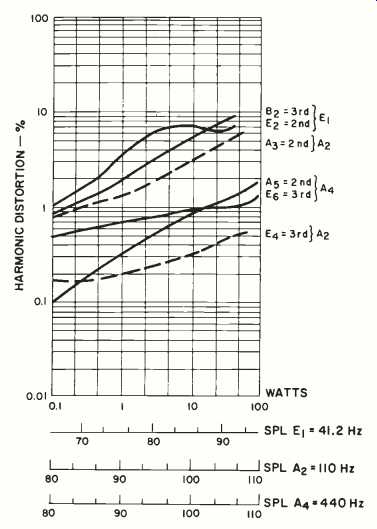
Fig. 8--Harmonic distortion for tones E1 (41.2 Hz), A2 (110 Hz), and A4
(440 Hz).
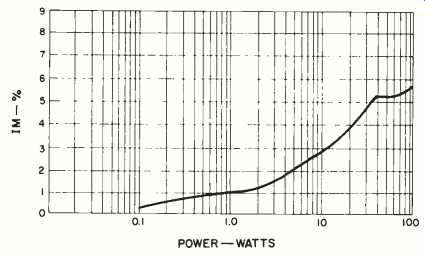
Fig. 9--IM distortion on A1 (440 Hz) when E1 (41.2 Hz) and A4 are mixed
one to-one.
The result of the energy-time test is shown in Fig. 10. The sound pressure remains within 20 dB of the peak arrival for a period of time slightly greater than 1 millisecond. The pressure wave from the woofer actually arrives 0.39 milli seconds before the first pressure component from the tweeter. The energy due to the woofer begins at 3.22 milliseconds, for a one-meter microphone to enclosure spacing, while the first tweeter component arrives at 3.61 milli seconds and peaks at 3.69 milliseconds. A multiplicity of later energy arrivals mars what might otherwise have been an excellent transient response.
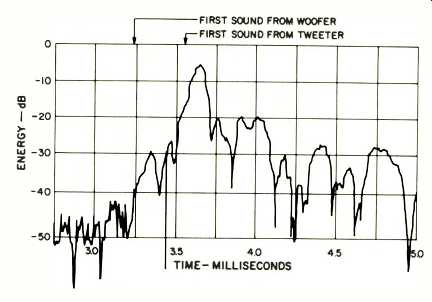
Fig. 10--Energy-time measurement at one meter on-axis.
Listening Test
Tannoy provides a good description for recommended loudspeaker placement, so I followed their recommendations closely. I did find that it was necessary to pull the systems for ward and away from any back wall so as to minimize an upper-bass heaviness. After extended listening, I found that preferred the Roll-off in its "level" position and the Energy at the "minus 1" position.
This system is very efficient and can both clear sinuses and break leases with very little effort from a powerful amplifier such as the Marantz 510 which I use. My overall impression was that the sound is similar to that of the Nakamichi Monitor system. There is no super low bass, a good balanced midrange with some emphasis, and the extreme tops are somewhat down. There is good articulation of transients, and this is one of the few loudspeakers which I believe does a good job of reproducing piano, a difficult instrument.
There is an emphasis of the upper range of pitch components which gives a bit of the so-called "West Coast" sound. As a result female vocals come through with a lot of punch.
Tannoy is correct in stating that the speakers should be angled toward the listener's position. When this is done there is a good lateralization of the stereo image with a moderately good sense of depth. Not absolutely perfect, but a lot better than most.
There are two accessories which would make this Tannoy an outstanding performer. The first is a sub-woofer. The Tannoy just does not have the extreme bottom end to match the quality of its mid and top ranges.
The second goodie would be an equalizer to pull down the 1 to 5 kHz range just a bit. I felt that bright program material could benefit from this adjustment, which is just not properly available with the equalizers that are provided. However, in sum, I liked the sound of this system.
- Richard C. Heyser
(adapted from Audio magazine, Dec. 1977)
Also see:
Tannoy 615 Speaker (Aug. 1992)
Technics T-400 Speaker System (Dec. 1975)
= = = =